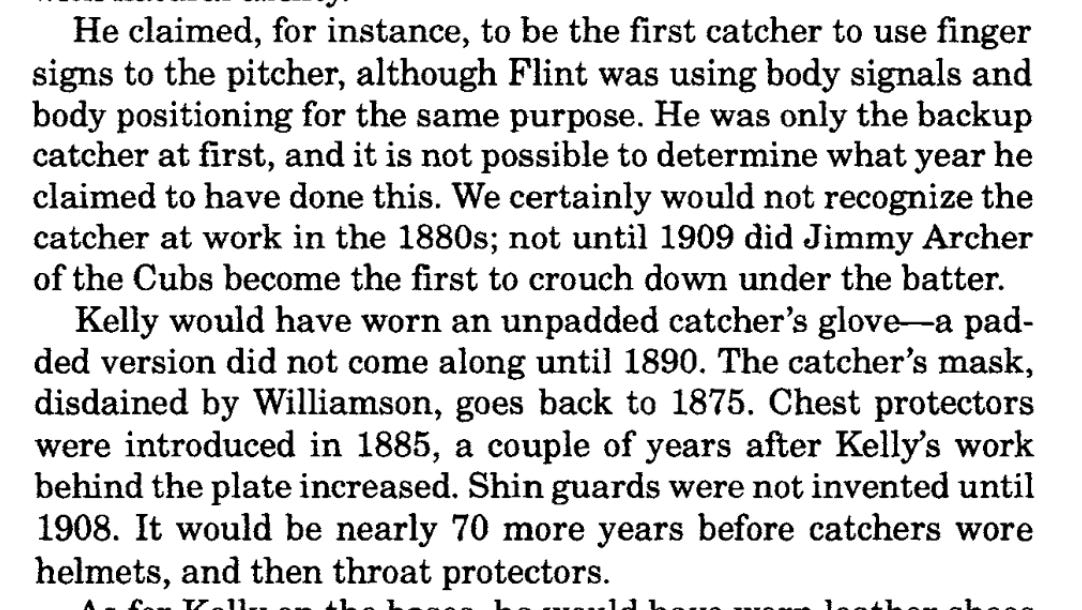The King of Cheaters
How King Kelly, one of baseball's most infamous cheaters, led the sport to its current sign stealing crisis
Welcome to a special Thursday edition of Sports Stories. I wasn’t planning on writing about baseball this week—after all the World Series has come and gone. But baseball sort of demanded it. So here’s a story about signs, stealing signs, and a legendary ballplayer who died from pneumonia at the age of 36.
Long before Ruth, Reggie, or A-Rod, the quintessential baseball star was a catcher for the Chicago White Stockings and Boston Beaneaters named Michael Joseph Kelly. But nobody knew him as Michael Joseph Kelly. The world of 19th century baseball knew him as King Kelly.
King Kelly was one of the first true celebrity athletes. He was a fine player, but he was more famous for how he played, and for what he did off the field, than for his actual baseball acumen. He was a big personality, a reckless drinker, and a creative problem-solver with a dapper mustache. The nickname King suited him.

He invented the hook slide (where you slide askew of the bag to avoid a tag, and then touch it with your hand instead of your foot). He may have been the first catcher to back up throws from the infield to first base.
He published the first athlete tell-all autobiography, his 1888 book Play Ball.
A century before Space Jam, he was the first athlete to use the (vaudeville) stage to expand his brand and bank account. Kelly would recite Casey at the Bat to swooning audiences—his performances of the poem became so popular that people came to mistakenly believe that Casey was based on Kelly himself.
He also may or may not have been the subject of America’s first recorded pop music hit. The writer Marty Appell makes a compelling case for the 1890 recording of the song “Slide, Kelly, Slide” as the first such hit.
King Kelly was at the forefront of baseball in his time. But baseball in his time looked a lot different from the modern sport. As a catcher, Kelly did not crouch behind home plate—he stood, as was the custom until the early 1900s. One of Kelly’s most notorious (or glorious) skills was cutting bases. Since there was usually only one umpire on the field, Kelly would cut straight from first to third base, or straight from second to home when the umpire had his back turned. This made him popular amongst fans and teammates. It didn’t go over great among opposing players, or the embarrassed umpires.
But in the primitive version of baseball being played, cutting bases classified as cutting edge. It was the best cheating he could pull off. The sport then, as it is now, was evolving. Soon, leagues began to employ multiple umpires to prevent base cutting. Another way baseball was evolving in King Kelly’s era? Pitchers were beginning to come to terms with the fact that they weren’t necessarily friends with batters. Early in the sport, pitchers worked *with* hitters, more or less. The relationship has been going downhill since.
For a great writeup on the earlier development of pitching (and hitting), check out this post from John Thorn, the dean of baseball historians. Among the big changes in the late 19th century was the evolution of pitches that weren’t fastballs: curveballs and slow balls entered the sport. And as they became more popular and effective, it became necessary to deploy them in a strategic way. Here we come to another great innovation in baseball: catcher signs.
King Kelly claimed to be the first catcher to use his fingers to signal to a pitcher whether he should throw a fastball or something else. This might be true, and it might not. Here’s Marty Appell on Kelly and signaling:

So it turns out that baseball’s most notorious rule breaker may have been responsible for the practice that has led the sport to its current crisis over rule breaking. In the years between the time King Kelly (may have) invented catcher signs, and the Astros started using cameras and trash cans to steal them and pass pitch types onto their hitters, the sport has seen all kinds of cheating—cheating that tends to rely on the best technology available. In the 1920s, it was sign stealing with telescopes and buzzers. In the ‘70s and ‘80s it was pine tar and corked bats. Then it was PEDs (though, to be fair to the Jose Cansecos of the world, those were technically not against the rules for a long time.)
For as long as there has been professional baseball, there have been professional baseball players willing to cheat to advance their teams and their own careers. The interesting thing about this to me is where we draw the lines: in baseball, it’s very clear. If you can steal signs with your eyes, while playing in the game, then that’s acceptable. It’s gamesmanship. When you bring technology from outside the field into play—well, that’s unethical.
But is that a false dichotomy? As baseball has evolved, the sport has become increasingly technologically advanced in ways that impact the game on the field just as much as sign stealing might. We now have cameras tracking every single rotation of a baseball as it travels from the mound to home plate, and we are now reverse engineering player’s biomechanics based on that data. We have a league with massive troves of proprietary data, and teams with their own troves. We have seen human bodies pushed to their limits, maximized for very specific skill sets in ways that would have been unimaginable to King Kelly and his peers.
More broadly speaking, the sport is now run in the manner of a financial market. The goals of the franchises increasingly seem to be related more to maximizing profits, and exploiting inefficiencies than to producing a joyful product. It’s not Moneyball as the plucky underdog story, it’s Moneyball as the monster that caused the 2008 financial crash. This is what we’ve seen in Houston. Right now, the Astros look a lot more like a bank skirting regulations than a baseball team. But they’ve won 100 games in three straight seasons.
If they’re the model franchise, what does that say about baseball? If cutting bases becomes the point, then is the game worth playing at all?
Related Reading
If you’re interested in King Kelly, you should start with the Appel’s biography, Slide, Kelly, Slide: The Wild Life and Times of Mike King Kelly. I’m also fond of Peter M. Gordon’s SABR biography of Kelly. Gordon describes Kelly as “professional baseball’s first matinee idol,” which is a pretty good legacy if you’re going to have one.
If you’re interested in reading more about performance optimization in baseball, the book to read is The MVP Machine by Ben Lindbergh and Travis Sawchick. But if you’re going to read it, I think it’s important to read Jack Hamilton’s review of the book inThe Atlantic as a useful counterbalance. Hamilton makes a lot of crucial points about the labor consequences of the techno-player era.
Take Me Out to the Ballgame
The mere existence of “Slide, Kelly, Slide” as a hit song in the 1890s is sort of hard to fathom. Not only because pop music (and recording technology) has changed so much since then, but because the relationship between music and sports has changed so much as well.
But in the late 19th and early 20th centuries, things were different. For example, “Take Me Out to the Ballgame” was written in 1908 by the Tin Pan Alley duo of Jack Norworth and Albert Von Tizler (what a name). Neither man had ever even been to a ballgame. But they understood the popularity of the sport. And they understood that a song about baseball would sell -- just as “Slide, Kelly, Slide” did. Here’s a recording of “Take Me Out to the Ballgame” from 1908:
The song was indeed a huge hit, telling the story of a baseball-mad woman named Katie Casey. (What we think of now as “Take Me Out to the Ballgame” is really just the chorus.) It was also, it turns out, a love song inspired by Jack Norworth’s affair with the suffragette Trixie Friganza. Friganza was a huge baseball fan. And her picture is even on the cover of the sheet music.
This is all covered in great detail by Anna Laymon in an article for Smithsonian that I highly recommend you check out:
Featuring a woman named Katie Casey who was “baseball mad,” who “saw all the games” and who “knew the players by their first names,” “Take Me Out to the Ballgame” tells the story of a woman operating and existing in what is traditionally a man’s space—the baseball stadium. Katie Casey was knowledgeable about the sport, she was argumentative with the umpires, and she was standing, not sitting, in the front row. She was the “New Woman” of the early 20th Century: empowered, engaged, and living in the world, uninhibited and full of passion. She was, historians now believe, Trixie Friganza.
This has been Vol. 9 of Sports Stories by Eric Nusbaum (words) and Adam Villacin (art). If you have any questions, comments, or concerns, please reply to this email or contact enusbaum@gmail.com. We’d love to hear from you.
Sports Stories is 100 percent free. If you enjoyed this week’s newsletter, and want to show your appreciation, the best way to do that would be to sign up, share it on social media, or forward it to someone you think might enjoy it too.


